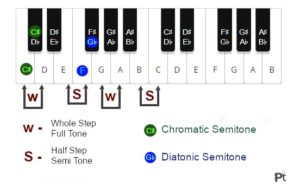Search Topic
What Is A Semitone And How It Affects The Sound Of Your Music Production.
A semitone is the distance between a node and its nearest one on a keyboard. It can also be named as half step. Here we know the pitch is the difference between two notes. So semitones can be explained in terms of pitch. Semitones are called the smallest interval in western music. In a 12-note approximately equally divided scale, any interval can be defined in terms of an appropriate number of semitones. They are a whole tone or major second is 2 semitones wide, a major third 4 semitones, and a perfect circle of fifth 7 semitones. The whole tone is just twice the size of a half-step/ semitone.
From accidental notes, we know the defining note can be marked by, ‘sharp’, ‘flat’, ‘natural’ signs. For sharp that indicates the note has been raised a semitone, and this is represented by the symbol, #, placed just before the note and on the same line or in the same space as the note head. The exact size of a semitone depends on the tuning system used for the creation of music.
Classifications of Semitone
Semitones can be classified into two main categories. They are –
- Chromatic semitones
- Diatonic semitones
Chromatic semitones
It’s the distance between a specific note and the same note preceded by either a flat or sharp one. The two notes are at the same staff position. An achromatic semitone is a very slightly wider interval than a diatonic semitone.
Diatonic Semitone
It is one between a note and the next note on a diatonic scale. It occurs when a half step contains two notes with different letter names.
Both the category of semitones can be interchanged at any time, with changing a few notes between them. Both are mirror images of each other.









